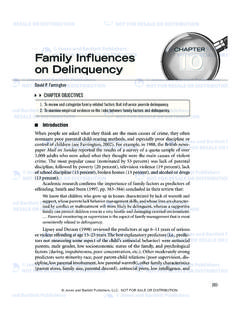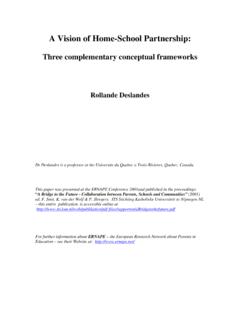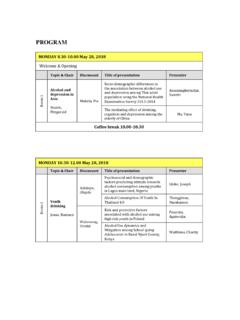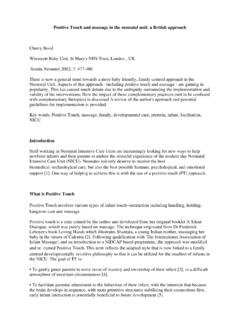Transcription of Effective Teaching and Learning for Pupils in Low ...
1 Research Report DCSF-RR011 Effective Teaching andLearning for Pupils in Low Attaining GroupsM ir ad Dunne, Sara Humphreys and Judy SebbaUniversity of SussexAlan Dyson, Frances Gallannaugh and Daniel MuijsUniversity of Manchester Effective Teaching and Learning forPupils in Low Attaining GroupsM ir ad Dunne, Sara Humphreys and Judy Sebba University of SussexAlan Dyson, Frances Gallannaugh and Daniel MuijsUniversity of ManchesterThe views expressed in this report are the authors and do not necessarily reflect those of the Departmentfor Children, Schools and Families.
2 University of Sussex 2007 ISBN 978 1 84775 048 8 Research Report NoDCSF-RR011iiAcknowledgmentsThe authors of this report would like to thank the staff and Pupils of the thirteen casestudy schools for their willing assistance and support during the course of thisresearch study. Thanks are also extended to the twelve Local Authority, EducationOfficers and to DCSF staff for their guidance and active support that facilitated theprogress and development of this research. We are extremely grateful to SylvieLomer in the University of Sussex for her efforts with the literature review and inputting this report together.
3 Finally we acknowledge the assistance andadministrative support of both Averil Gould in the School of Education, University ofManchester and Peter Boddy in the University of iiList of Tables ..viList of Appendices .. viiList of Abbreviations .. viiiExecutive ixChapter The education of low attaining The current of the of the of the and low attaining to Structure of the report6 Chapter 2. are the positive effects that have been linked toattainment grouping? are the negative effects that have been linked toattainment grouping? do schools motivate Pupils in lower attaining groups?
4 Policy grouping11 Chapter 3. Research to the The and 4. Predictors of Set Characteristics of low set School Meal Educational Modeling the predictors of 6 Year 6 5. The Organisation of Pupil Groups of Organisation and Rationales for Grouping Stage Stage Three and Key Stage is the Composition of Attainment Groups Decided? makes decisions? for allocating Pupils to different attainment to are the low attainers? Institutional Strategies Supportingthe Learning of Low-attaining resources to support the Learning of low in support resource provision and assessment at Key Stage for provision and assessment at Key Stages 3 and with neighbouring Learning support strategies and positive ethos systems External Involvement agencies Summary 70vChapter Classroom Strategies Supportingthe Learning of Low-attaining Teaching assistant on support the use of material resources.
5 Pedagogy and the needs of low attainers in the and ensuring forms of learner engagement and 8. Effective Teaching and Learning for LowAttaining Pupils an overview What are the population characteristics of Pupils in lowattainment sets? What practices and processes do schools use to identifyand organise low attainment groups? Pupil grouping Identifying low do schools and teachers motivate and inspire lowattaining Pupils to learn? Concentration of Learning environment different approaches used for Pupils from specific socialgroups (minority ethnic/social class/ gender) who are over-represented in low attainment groups and/or at risk of loweducational outcomes?
6 98 Chapter 9. Implications of the study Introduction grouping debate 106 Appendices I - XviList of TablesTable case study sample summaries14 Table composition of the survey sample16 Table Initial themes for case study data analysis17 Table The basis for decisions on setting in primary and secondaryschools20 Table selected summary of the ACORN categories21 Table Gender by sets21 Table Ethnicity by sets22 Table FSM by sets23 Table ACORN categories by set23 Table SEN by sets25 Table Prior attainment in English
7 By sets25 Table Prior attainment in Maths by sets25 Table Schools using attainment setting in Key Stage Two31 Table Grouping arrangements in case study schools atKey Stage Two 32 Table Schools using attainment setting in Key Stage Threeand Four33viiList of AppendicesAppendix ICase study sampleAppendix IISurvey InstrumentAppendix IIII nterview ScheduleAppendix IVAcorn CategoriesAppendix VAnalysis of Key Stage 2 numeracyAppendix VIAnalysis of Key Stage 2 literacyAppendix VIIA nalysis results of secondary mathematicsAppendix VIIIA nalysis results of secondary EnglishAppendix IXTechnical rational for the analytical approachAppendix XSchool case studies (a-m)
8 Viii List of abbreviationsACORNA Classification of Residential NeighbourhoodsCAT Cognitive Abilities TestDfEEDepartment for Education and EmploymentDfESDepartment for Education and SkillsEALE nglish as an Additional LanguageGCSEG eneral Certificate of Secondary EducationKS1-4 Key Stages 1-4 LMLearning MentorMLR Multinomial Logistic RegressionNPD National Pupil DatabasePLASCP upil Level Annual School CensusPLUM Polytomous Universal ModelSEN Special Educational NeedsFSM Free School MealsLALocal AuthoritiesLEAL ocal Education AuthorityNCNational CurriculumOfstedOffice For Standards in EducationPTAP arent Teacher AssociationQCAQ ualifications and Curriculum AuthoritySATsScholastic Aptitude TestsSENS pecial Educational NeedsSESS ocio Economic StatusSPSSS tatistical Package for the Social SciencesTATeaching AssistantUPNU nique Pupil NumbersVAValue AddedixEXECUTIVE SUMMARYB ackgroundThe research investigated the characteristics of Pupils in low attainment sets, thefactors that determine the composition of these sets and the approaches to effectiveteaching of Pupils in low attainment groups used by schools.
9 Central to the aims ofthe study was the identification of how schools and teachers maximise the benefits ofattainment grouping and mitigate its disadvantages. It was conducted by theUniversities of Sussex and Manchester, on behalf of the Department for Children,Schools and Families (DCSF). While the main focus was on low attainment sets,consideration was also given to Effective Teaching approaches with Pupils regardedas low attaining in other grouping arrangements and more generically within thebroader school study sought to answer four key research questions:1.
10 What are the population characteristics of Pupils in low attainment sets?2. What practices and processes do schools use to identify and organise lowattainment groups?3. How do schools and teachers motivate and inspire Pupils in low attaining groups tolearn?4. Are different approaches used for Pupils from specific social groups (minorityethnic/social class/ gender) who are over-represented in low attainment groupsand/or at risk of low educational outcomes?Key FindingsThere were three main ways in which schools and teachers motivate and inspire lowattaining Pupils to learn.

















